The Crested Serpent Eagle (Spilornis cheela) stands as a majestic symbol of avian grace and predatory prowess in the skies of Asia.
With its distinctive crest and keen eyesight, this raptor commands attention and admiration from bird enthusiasts and researchers alike.
In this comprehensive bio, we delve into the intricate details of the Crested Serpent Eagle, exploring its habitat, behavior, diet, and conservation status.
From the dense forests of the Indian subcontinent to the tropical landscapes of Southeast Asia, the Crested Serpent Eagle embodies resilience and adaptability in diverse ecosystems.
Join us as we unravel the mysteries and unveil the majesty of this captivating bird of prey.
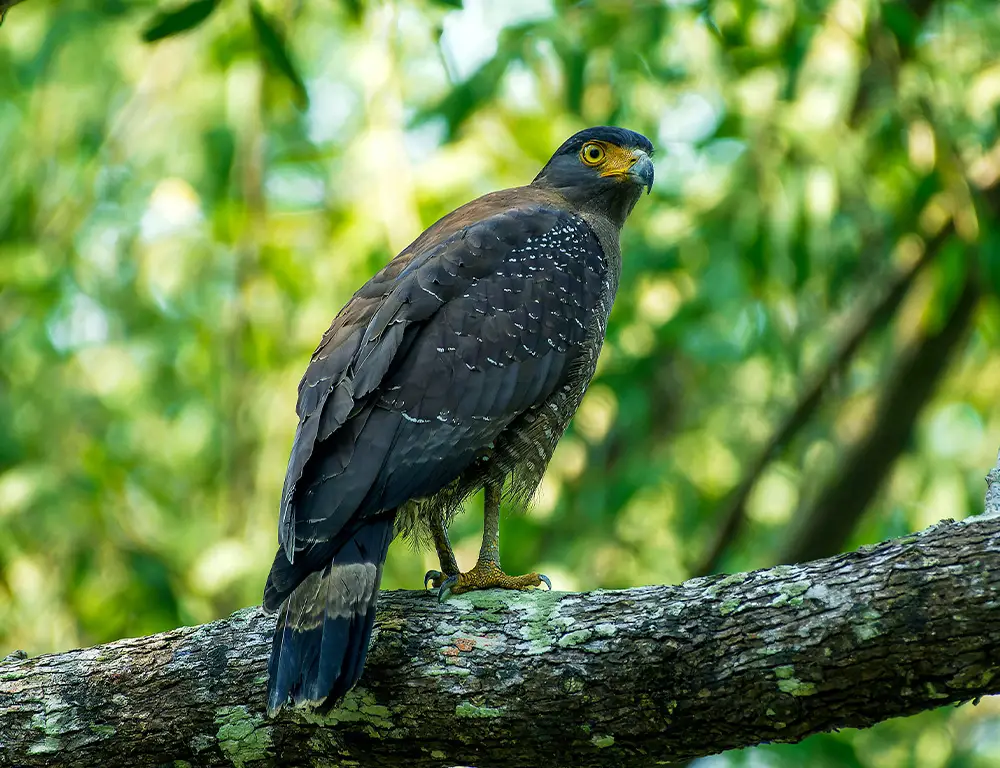
Taxonomy and Classification of Crested Serpent Eagle
The Crested Serpent Eagle (Spilornis cheela) belongs to the family Accipitridae, which encompasses birds of prey such as eagles, hawks, and kites.
This species is further classified into several subspecies based on geographical distribution and slight morphological differences.
| Kingdom | Animalia |
| Phylum | Chordata |
| Class | Aves |
| Order | Accipitriformes |
| Family | Accipitridae |
| Genus | Spilornis |
| Species | S. cheela |
The Crested Serpent Eagle (Spilornis cheela) exhibits several subspecies in Asia. Here’s an elaboration on some of the notable subspecies:
Spilornis Cheela Cheela
This subspecies, commonly known as the Indian Crested Serpent Eagle, is in the Indian subcontinent. It typically inhabits wooded areas, forests, and open countryside.
Its plumage varies from dark brown to reddish-brown, with distinct white spots on the wings and underparts.
Spilornis Cheela Pallidus
The Eastern Crested Serpent Eagle, also called Spilornis cheela pallidum, is found in Southeast Asia, including regions of Myanmar, Thailand, Laos, Cambodia, and Vietnam.
It is characterized by lighter plumage, with a pale underside and faint streaks compared to other subspecies.
Spilornis Cheela Spilogaster
This subspecies, commonly known as the Philippine Serpent Eagle, is endemic to the Philippines. It has a distinctive appearance with dark brown plumage, a prominent crest, and bold white streaks on the underparts.
Spilornis Cheela Hoya
Found in Taiwan, Spilornis Cheela Hoya exhibits unique characteristics such as a dark brown crest and dark brown upperparts with prominent white spots.
Spilornis Cheela Perplexus
The Andaman Serpent Eagle, a subspecies found exclusively in India’s Andaman Islands, is known for its dark brown plumage and distinctive white markings on the underparts.
Spilornis Cheela Melanotis
This subspecies is found in the Nicobar Islands of India. It has a dark brown crest and upper parts, with prominent white markings on the underparts similar to other subspecies.
These subspecies demonstrate slight variations in plumage coloration, size, and habitat preferences, reflecting adaptation to diverse environments.
Studying these subspecies provides valuable insights into the Crested Serpent Eagle’s evolutionary history and ecological dynamics.
Crested Serpent Eagle Physical Characteristics
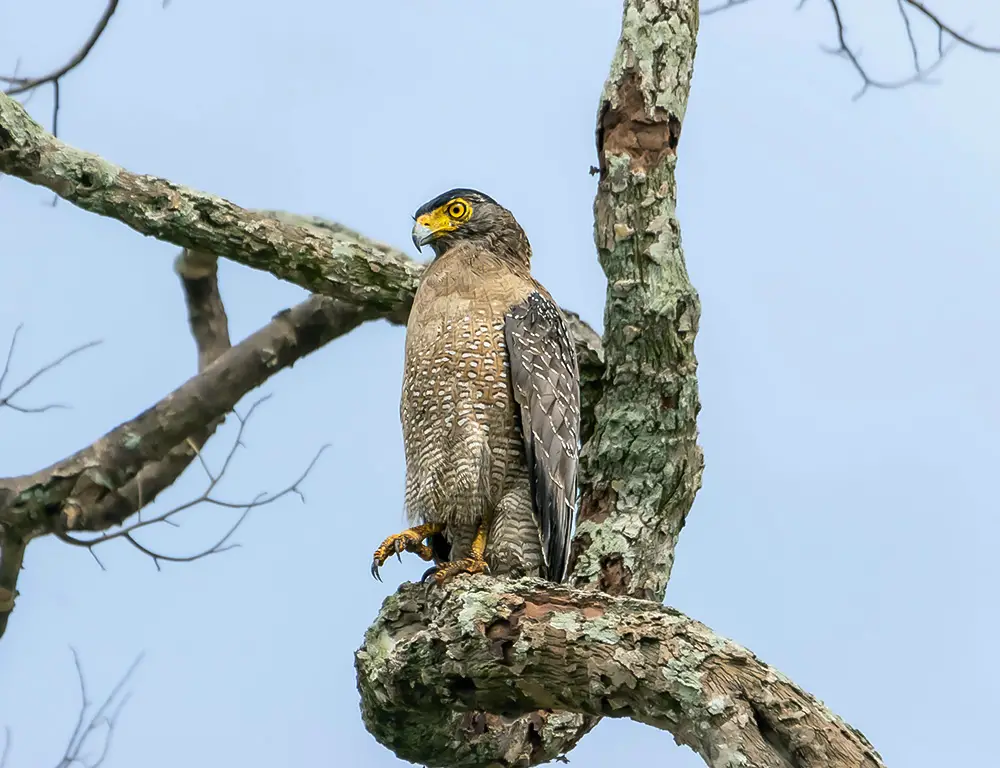
The Crested Serpent Eagle (Spilornis cheela) is a medium-sized bird of prey with several distinctive physical characteristics:
Crest
As its name suggests, the Crested Serpent Eagle has a prominent crest on its head. This crest consists of feathers that can be raised or lowered, often used for display or communication.
Size
On average, Crested Serpent Eagles measure around 55 to 75 centimeters (22 to 30 inches) in length. Their wingspan ranges from 115 to 134 centimeters (45 to 53 inches).
Plumage
The plumage of Crested Serpent Eagles varies depending on the subspecies. Generally, they have dark brown to reddish-brown upperparts with lighter underparts.
Some subspecies feature distinctive white spots, streaks, or markings on the wings and underparts. The plumage serves as camouflage in their wooded habitats.
Beak and Talons
Like other raptors, Crested Serpent Eagles have strong, hooked beaks used for tearing apart prey.
Their talons are sharp and powerful, enabling them to grasp and subdue a variety of prey items, including reptiles, birds, and small mammals.
Eyes
These eagles have large, yellow eyes, providing them with excellent vision for hunting. Their keen eyesight allows them to spot prey from a considerable distance while soaring high above the forest canopy.
Flight
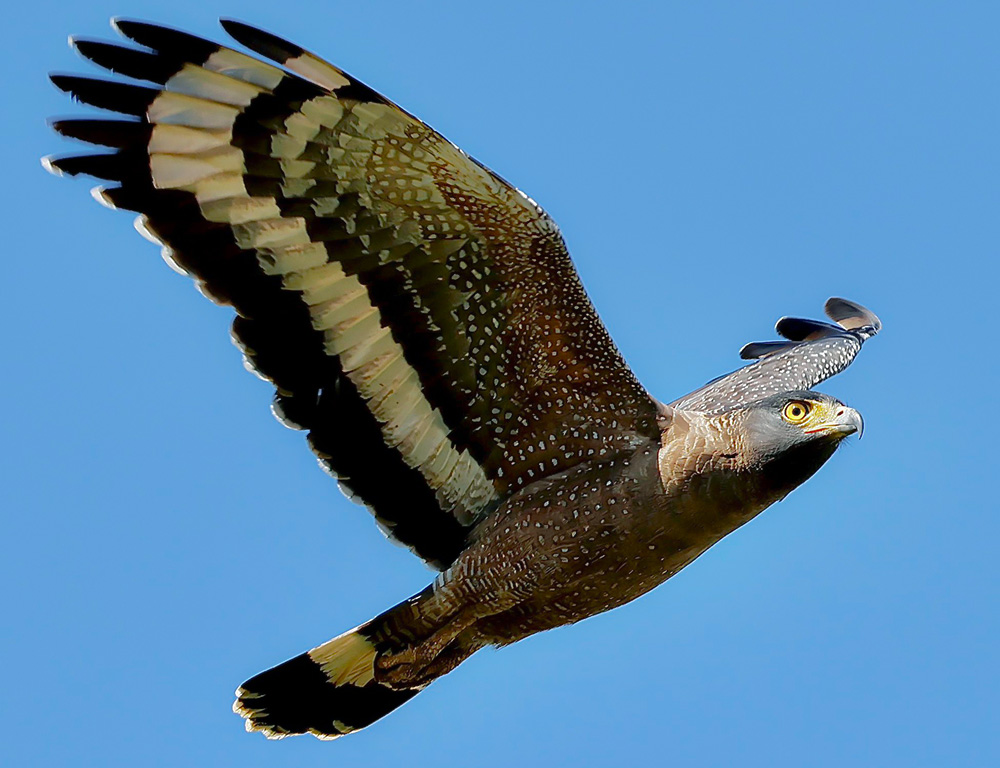
Crested Serpent Eagles are agile fliers, often seen gliding effortlessly through the air as they search for prey.
They have broad wings and a buoyant flight style, utilizing thermal updrafts to soar and conserve energy during long-distance flights.
Sexual Dimorphism
In some cases, male and female Crested Serpent Eagles may exhibit slight differences in size, with females being slightly larger than males.
Additionally, females may have broader wings and larger feet to accommodate their role in nesting and raising young.
These physical characteristics enable Crested Serpent Eagles to thrive in various forested habitats across their range, playing a vital role as apex predators in their ecosystems.
Crested Serpent Eagle’s Habitat and Range Map

The Crested Serpent Eagle (Spilornis cheela) inhabits various forested habitats across its extensive range in Asia. Here are some details about its habitat preferences and a description of its range:
Habitat Preferences
- Forests: Crested Serpent Eagles are commonly found in both primary and secondary forests, including tropical rainforests, deciduous forests, and mixed evergreen forests.
- Woodlands: They also inhabit wooded areas, including open woodlands, scrublands, and forest edges.
- Hills and Mountains: In some regions, Crested Serpent Eagles occur in hilly or mountainous terrain, where they inhabit forested slopes and valleys.
- Wetlands: While they primarily occur in forested habitats, Crested Serpent Eagles may also frequent wetlands, marshes, and riverine areas, especially during the non-breeding season.
Range
The Crested Serpent Eagle has a wide distribution across South and Southeast Asia. Its range extends from the Indian subcontinent to Southeast Asia, including countries such as:
- India
- Nepal
- Bhutan
- Bangladesh
- Myanmar
- Thailand
- Laos
- Cambodia
- Vietnam
- Malaysia
- Indonesia
- Philippines
- Taiwan
Please note that the actual range of the Crested Serpent Eagle may vary within these countries and may occur in localized populations within their range.
Additionally, habitat loss, fragmentation, and human disturbance can influence their distribution within these areas.
Reproduction and Nesting Habit of Crested Serpent Eagle
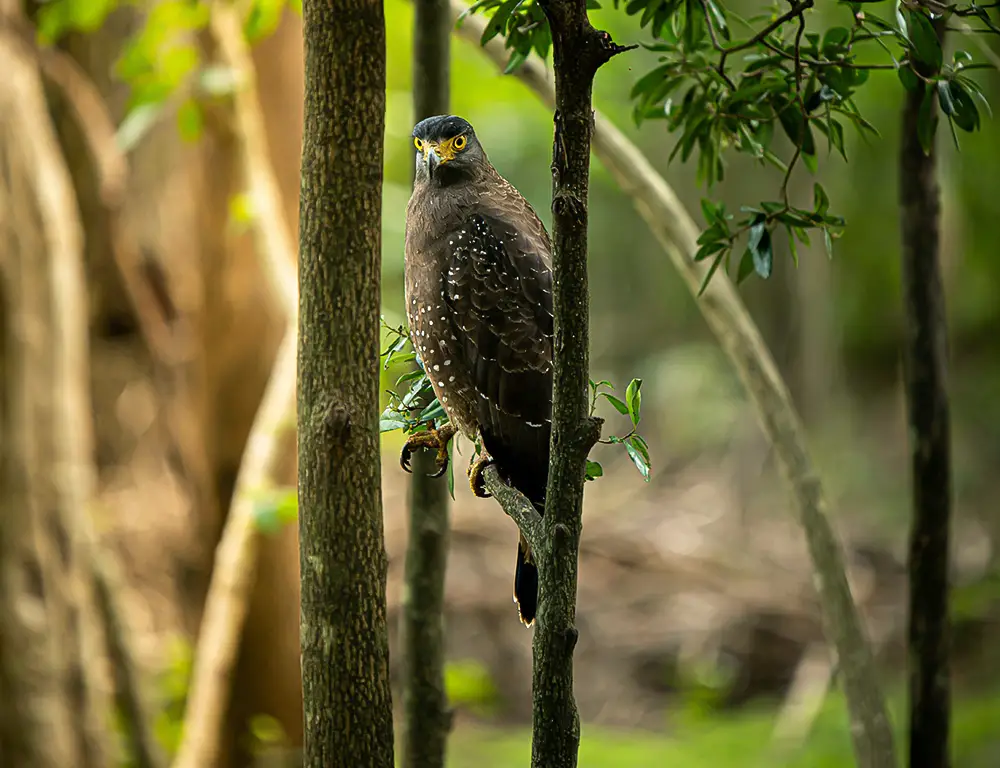
The Crested Serpent Eagle (Spilornis cheela) follows a typical raptor breeding pattern characterized by territoriality, courtship displays, and nest-building. Here’s an overview of their reproduction and nesting habits:
Breeding Season
The breeding season for Crested Serpent Eagles varies depending on their geographic location but generally occurs during the dry season when prey availability is higher.
Breeding pairs establish and defend territories, which they occupy year-round.
Courtship Displays
Before mating, Crested Serpent Eagles engage in elaborate courtship displays to reinforce pair bonds and establish breeding territories. These displays often involve aerial acrobatics, vocalizations, and mutual feeding between males and females.
Nest Site Selection
Crested Serpent Eagles typically build their nests in tall trees within their territory. They prefer densely forested areas with sufficient canopy cover for protection and concealment.
Nests are often constructed in sturdy branches near the tree trunk, providing stability and security for the eggs and nestlings.
Nest Construction
The female primarily carries out the nest-building process, although the male may assist by gathering nesting materials.
Nests are constructed using sticks, twigs, and other plant materials and are lined with softer materials such as leaves, moss, or feathers.
Egg-laying and Incubation
After the nest is built, the female lays a clutch of typically one to two eggs. Both parents share incubation duties and last for about 40 to 50 days.
During this time, the parents take turns incubating the eggs while the others hunt for food.
Parental Care
Once the eggs hatch, both parents feed and care for the chicks. Young Crested Serpent Eagles are altricial, meaning they are born helpless and rely entirely on their parents for food and warmth.
The parents tear food into small pieces and feed it to the chicks until they are old enough to feed themselves.
Fledging and Independence
Nestlings remain in the nest for approximately 60 to 70 days before fledging. After fledging, young Crested Serpent Eagles depend on their parents for several weeks as they learn to hunt and become proficient fliers.
Eventually, they became independent and dispersed to establish their territories.
Throughout the breeding season, Crested Serpent Eagles invest significant time and energy into ensuring their offspring’s survival, contributing to their populations’ sustainability within their respective habitats.
Make a table on the nesting details of the Crested Serpent Eagle. Includes facts like Clutch Size, Number of Broods, Egg Length, Egg Width, Incubation Period, Nestling Period, Egg Description, etc.
Feeding Habits of Crested Serpent Eagle
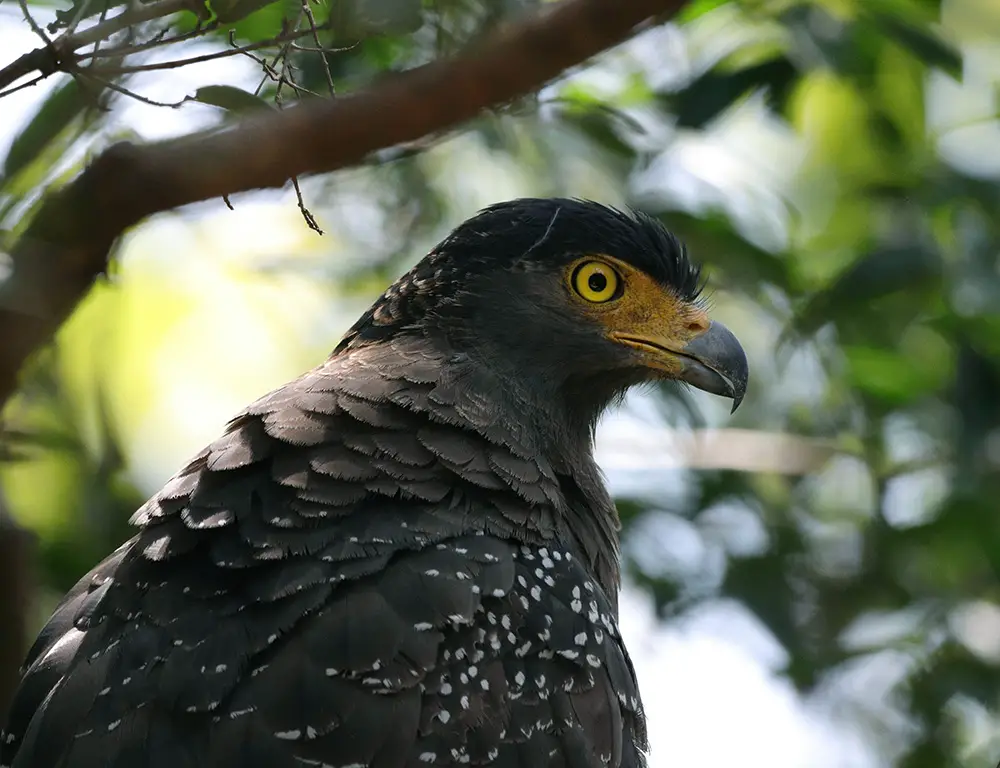
The Crested Serpent Eagle (Spilornis cheela) is a formidable predator with a diverse diet primarily consisting of reptiles, especially snakes. Here are details about its feeding habits:
Snake Specialist
As the name suggests, Crested Serpent Eagles are specialized hunters of snakes. They have adapted morphological features such as sharp talons and a powerful beak to capture and subdue their serpentine prey.
They are known to feed on various snake species, including both venomous and non-venomous snakes.
Other Prey
While snakes are their preferred prey, Crested Serpent Eagles consume a range of other animals. This may include lizards, frogs, small mammals like rodents, birds, and occasionally large insects.
Hunting Techniques
Crested Serpent Eagles primarily hunt from perches within their forested habitats. They use their keen eyesight to spot prey from a high vantage point, then swoop down to capture it with their powerful talons.
When hunting snakes, they may seize them mid-flight or snatch them from the ground or vegetation.
Opportunistic Feeders
Despite their preference for snakes, Crested Serpent Eagles are opportunistic feeders and will take advantage of other prey items. They may scavenge carrion or feed on small mammals and birds if snakes are scarce.
Feeding Behavior
After capturing prey, Crested Serpent Eagles typically carry it back to a perch where they can consume it at leisure. They use their sharp beak to tear apart the prey and may swallow smaller prey whole.
More oversized prey items may be consumed over multiple feedings or shared with offspring during the breeding season.
Role in Ecosystem
As apex predators, Crested Serpent Eagles play a crucial role in maintaining the balance of their ecosystems by controlling populations of snakes and other prey species.
Their presence helps regulate prey populations and contributes to forested habitats’ overall health and stability.
Overall, the Crested Serpent Eagle’s feeding habits highlight its importance as a top predator in Asian forests, particularly in controlling populations of snakes, which are often considered pests in human-inhabited areas.
Wrapping Up
The Crested Serpent Eagle epitomizes the beauty and resilience of nature’s avian wonders. As we’ve explored its habitat, behaviors, and conservation status, it becomes evident that preserving its existence is paramount.
By understanding and appreciating the significance of this magnificent raptor, we pave the way for practical conservation efforts to safeguard its future.
As stewards of the natural world, it’s our responsibility to ensure that future generations can continue to marvel at the majesty of the Crested Serpent Eagle soaring gracefully through the skies.
Let us strive to protect this emblematic bird and the rich biodiversity it represents, fostering a harmonious balance between humanity and the environment.